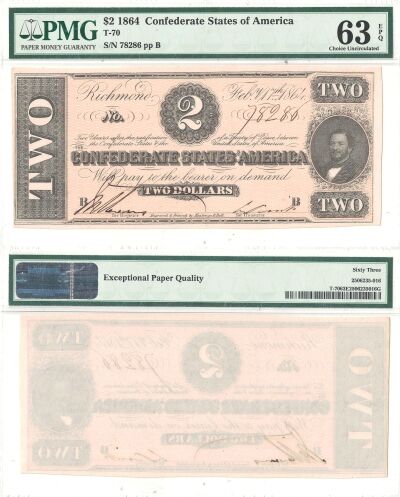Confederate Currency
When the Confederacy seceded from the Union in 1861, it immediately began issuing paper currency. The Confederacy struck no coinage, so paper money was the staple of everyday commerce.
Between 1861 and 1865, the Confederate States of America issued over 100 varieties of currency, some very rare, others very affordable. All are colorful and historically important, and feature vignettes of Confederate heroes, officials and buildings. You can find notes portraying Jefferson Davis, Gen. Thomas "Stonewall" Jackson, and the Confederate capitol of Richmond.
With increased interest in our Civil War history, the issues of the Confederate States have become more and more desirable, with the earlier issues becoming increasingly hard to find. We try and stock as many interesting Confederate notes as we can as we have seen interest in this fascinating area of collecting explode in recent years.
- Found 15 items
 1861. $10. PMG. VF-25. T-24.$450.00
1861. $10. PMG. VF-25. T-24.$450.00Solid for the grade with plenty of remaining brightness and eye appeal.
Item #242248 (1 / 15) 1861. $5. PMG. Ch Unc-63. T-36.$875.00
1861. $5. PMG. Ch Unc-63. T-36.$875.00Vignettes include Ceres, goddess of agriculture, on bales of cotton in the center. Well inked for the issue and pleasing paper.
Item #250303 (2 / 15) 1861. $50. PCGS. Ch New-63. PPQ. T-8.$575.00
1861. $50. PCGS. Ch New-63. PPQ. T-8.$575.00A bright note with a full inner frame, strong color and premium paper. A commonly found blue rubberstamped 'C', whos purpose remains unclear, can be found on the left.
Item #251377 (3 / 15) 1861. $50. PCGS. VF-30. T-16.$339.00
1861. $50. PCGS. VF-30. T-16.$339.00PF-3. CR-81. Engraver above fundable. Fully margined with a portrait of Jefferson Davis and a bright look.
Item #246783 (4 / 15) 1862. $100. PCGS. Ch AU-58. PPQ. T-49.$695.00
1862. $100. PCGS. Ch AU-58. PPQ. T-49.$695.00No Series. Watermark: Block CSA. Portrait of Lucy Pickens, Green reverse. A pleasing note with strong color and bright original paper.
Item #210981 (5 / 15) 1862. $100. PMG. Ch AU-58. EPQ. T-41.$275.00
1862. $100. PMG. Ch AU-58. EPQ. T-41.$275.00A central vignette features slaves hoeing cotton. Color and signatures are both pleasing and paper is premium.
Item #217287 (6 / 15) 1862. $100. PMG. Ch Unc-64. EPQ. T-41.$425.00
1862. $100. PMG. Ch Unc-64. EPQ. T-41.$425.00A central vignette features slaves hoeing cotton. Fully framed and premium paper is bright. Stampings show 3 interest payments.
Item #241358 (7 / 15) 1862. $100. PMG. VF-30. T-49.$375.00
1862. $100. PMG. VF-30. T-49.$375.00Portrait of Lucy Pickens. A very attractive note with good color and plenty of remaining brightness.
Item #251308 (8 / 15) 1862. $2. PMG. Ch Unc-63. T-54.$325.00
1862. $2. PMG. Ch Unc-63. T-54.$325.00Portrait of Judah P. Benjamin. Pink Paper. Bright paper with a fresh appearance.
Item #247260 (9 / 15) 1863. $100. PMG. Ch Unc-63. EPQ. T-56.$585.00
1863. $100. PMG. Ch Unc-63. EPQ. T-56.$585.00Portrait of Lucy Pickens. Green Reverse. A fresh looking note with premium paper and strong eye appeal.
Item #239595 (10 / 15) 1863. $50. PCGS. Very Ch-64. T-57.$950.00
1863. $50. PCGS. Very Ch-64. T-57.$950.00Portrait of Jefferson Davis, President of the Confederate States of America. An attractive note with strong green, black, and red inks. The paper is bright and pleasing.
Item #250861 (11 / 15) 1864. $100. PCGS. Very Ch-64. PPQ. T-65.$675.00Choose from 2 different notes!Item #251309 (12 / 15)
1864. $100. PCGS. Very Ch-64. PPQ. T-65.$675.00Choose from 2 different notes!Item #251309 (12 / 15) 1864. $2. PMG. Ch Unc-63. EPQ. T-70.$259.00
1864. $2. PMG. Ch Unc-63. EPQ. T-70.$259.00Portrait of Judah P. Benjamin, CSA Secretary of State at right. Full margins and crisp with premium paper.
Item #242331 (13 / 15) 1864. $50. PMG. Ch Unc-64. T-66.$435.00
1864. $50. PMG. Ch Unc-64. T-66.$435.00Portrait of Jefferson Davis, President of the Confederate States of America. Pleasing pink and black color blends with bright paper. The design is full, but the border is a little tight on the right.
Item #251007 (14 / 15) 1864. $500. PMG. VF-30. T-64.$675.00
1864. $500. PMG. VF-30. T-64.$675.00Portrait of Stonewall Jackson. An attractive note with light pink underprint and strong color. The paper is bright and signatures are strong.
Item #241659 (15 / 15)- 15 items found















